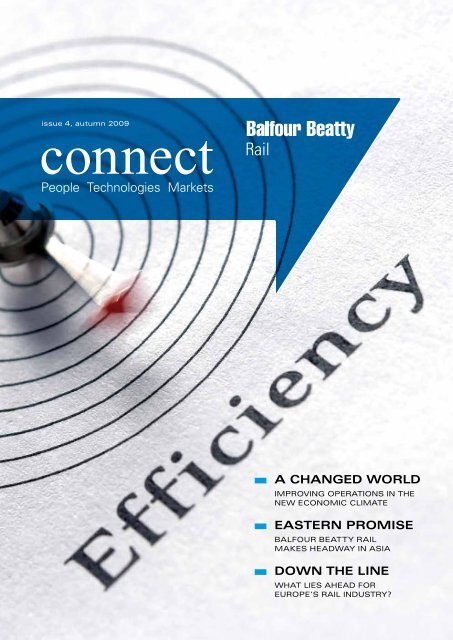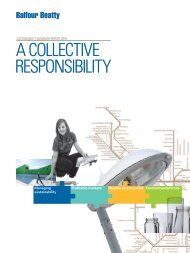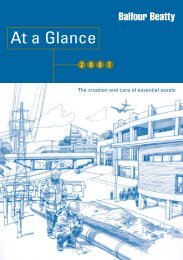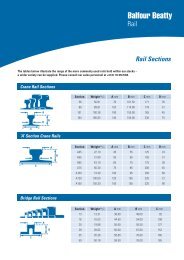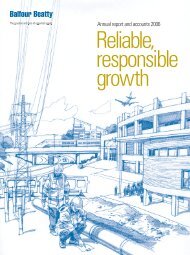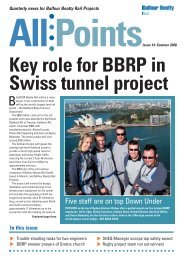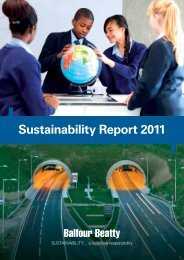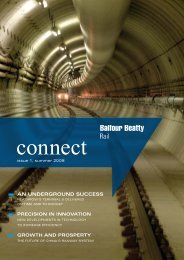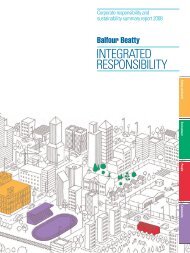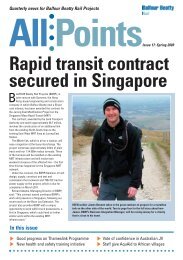People Technologies Markets - Balfour Beatty Rail
People Technologies Markets - Balfour Beatty Rail
People Technologies Markets - Balfour Beatty Rail
You also want an ePaper? Increase the reach of your titles
YUMPU automatically turns print PDFs into web optimized ePapers that Google loves.
issue 4, autumn 2009<br />
<strong>People</strong> <strong>Technologies</strong> <strong>Markets</strong><br />
A chAnged world<br />
ImprovIng operatIons In the<br />
new economIc clImate<br />
eAstern promise<br />
<strong>Balfour</strong> <strong>Beatty</strong> raIl<br />
makes headway In asIa<br />
d own the line<br />
what lIes ahead for<br />
europe’s raIl Industry?
These are challenging times for any<br />
industry, but those in the rail infra structure<br />
business face the future with a clear set of<br />
priorities. This issue of connect explores<br />
what that future may look like – for<br />
suppliers, customers and passengers.<br />
Now more than ever, there is a need<br />
for companies like ours to work more<br />
closely with customers to deliver value<br />
across the life of projects – something<br />
we explore in our feature on efficiency<br />
and client relationships (p4) in the UK,<br />
Germany and Sweden.<br />
On page 18, we find out how technology,<br />
in the shape of remote condition monitoring,<br />
has the potential to revolutionise track<br />
maintenance.<br />
We also reveal how clients are helping us<br />
achieve our target of reaching Zero Harm<br />
by 2012 (p14).<br />
The future is also the focus of UNIFE<br />
and Boston Consulting Group’s engaging<br />
study on the European rail industry. As<br />
you’ll read on page 16, the landscape could<br />
look very different for all the major players<br />
come 2025.<br />
The urban transport challenges discussed<br />
in the study have a resonance for two<br />
important, but very different, markets<br />
featured in this issue. On page 20, we<br />
discover how Germany is tackling the<br />
problem of an overcrowded network while<br />
pressing ahead with high-speed development,<br />
while on page 8, we explore how <strong>Balfour</strong><br />
<strong>Beatty</strong> <strong>Rail</strong> is rising to the task of shaping<br />
the future of rail in south-east Asia.<br />
In Malaysia, work on the power and<br />
electrification of the Ipoh-Padang Besar<br />
section of the North-South line continues<br />
apace. As our exclusive interview with the<br />
Minister of Malaysian <strong>Rail</strong>ways (p10)<br />
reveals, the country has ambitious plans to<br />
editoriAl | 3<br />
attract more commuters away from the road,<br />
especially to its intercity services. And in<br />
Singapore, Gammon Construction is playing<br />
a growing part in realising the masterplan of<br />
the Singapore Land Transport Authority.<br />
In Panorama (p22-23), you’ll find the<br />
latest news and analysis, including details of<br />
<strong>Balfour</strong> <strong>Beatty</strong>’s proposed acquisition of<br />
Parsons Brinckerhoff.<br />
Finally, thank you to those who took time<br />
to complete the questionnaire in the last<br />
issue. Your feedback is invaluable as we<br />
continue to improve connect. If you have<br />
comments or suggestions on the magazine,<br />
or would like to receive regular updates<br />
from <strong>Balfour</strong> <strong>Beatty</strong> <strong>Rail</strong>, please email<br />
connect@bbrail.com.<br />
Manfred Leger<br />
Group Managing Director <strong>Balfour</strong> <strong>Beatty</strong><br />
connect «
8 | mArkets<br />
For almost half a century, plans have been<br />
in the pipeline for creating an 89,900km rail<br />
network across Asia, linking 28 countries<br />
and enabling passengers to step on a train in<br />
Singapore and step off in Shanghai or travel<br />
from Seoul to Samarkand, Uzbekistan. The<br />
Trans-Asian <strong>Rail</strong>way Network, originally<br />
launched by the United Nations Economic<br />
and Social Commission for Asia and the<br />
Pacific, has been plagued by setbacks over<br />
the decades. Everything from political and<br />
economic strife to differences in national<br />
track gauges has stood in the way of its<br />
progress. But now, as an intergovernmental<br />
agreement signed in 2006 comes into force,<br />
the pace looks set to pick up.<br />
Impressive scale<br />
If it does, one country whose commitment<br />
will be required is Malaysia where <strong>Balfour</strong><br />
<strong>Beatty</strong> <strong>Rail</strong> has had a presence for more than<br />
a decade. “A lot of the countries involved<br />
are struggling to build the infrastructure in<br />
their section, but Malaysia is making great<br />
inroads into achieving just that,” says John<br />
Kirton, Managing Director of <strong>Balfour</strong><br />
<strong>Beatty</strong> <strong>Rail</strong> Malaysia.<br />
›› connect autumn 2009<br />
Part of the preparation involves<br />
substantial work on the main North-South<br />
line from Thailand to Singapore. <strong>Balfour</strong><br />
<strong>Beatty</strong> <strong>Rail</strong> has already had a significant role<br />
in this, having successfully completed an<br />
electrification project for the Rawang-Ipoh<br />
section of the route.<br />
Today, it is working on a scheme to<br />
double track and electrify more than 700km<br />
of the existing single track line. The project<br />
is a joint venture with Ansaldo STS on<br />
behalf of the main contractor MMC-<br />
Gamuda, and the scale is impressive.<br />
“It is one of the largest single projects that<br />
the Malaysian Government has undertaken,”<br />
says John Kirton. “It stretches over four<br />
northern states of West Malaysia, and<br />
includes 30 stations and yards, two depots,<br />
107 bridges and 100 river bridges.”<br />
Also ongoing is a 15km extension to the<br />
existing Klang Valley commuter network,<br />
due for completion in early 2010. When<br />
completed, the network will serve a densely<br />
populated area that is also popular with<br />
Gaining traction<br />
<strong>Rail</strong> infrastructure is a huge<br />
growth area in Asia, where <strong>Balfour</strong><br />
<strong>Beatty</strong> <strong>Rail</strong> is putting down roots in<br />
two neighbouring countries with<br />
very different travel requirements.<br />
By Alex Elliott<br />
tourists during Thaipusam celebrations<br />
for the local Indian community.<br />
singapore success<br />
Meanwhile, in Malaysia’s southerly<br />
neighbour Singapore, where rail<br />
infrastructure is advancing at a fast pace,<br />
<strong>Balfour</strong> <strong>Beatty</strong> <strong>Rail</strong> is already well<br />
established.<br />
Gammon Construction, a construction<br />
contractor jointly owned by <strong>Balfour</strong> <strong>Beatty</strong><br />
and Asian conglomerate Jardine Matheson,<br />
has been working in the region for nearly<br />
50 years and in Singapore for 25 years on<br />
a range of civil engineering, residential,<br />
industrial and transport projects.<br />
Indeed, until the mid-1990s, it was the<br />
only contractor ever to have built a railway<br />
in Singapore.<br />
In recent years, competition in the sector<br />
has been fierce, and today Gammon is<br />
aiming to strengthen its grip on the local<br />
market once again. The team is currently<br />
working on the Singapore metro’s Jurong<br />
East Modification Project (JEMP), an
extension to the city’s North-South line. “It’s<br />
quite a significant job because it will involve<br />
doing the first tie-in with an existing line<br />
that’s been done in Singapore,” says David<br />
Suff, Executive Director of Gammon<br />
Construction Singapore.<br />
The next goal is to win a contract for<br />
the Tuas extension, a 5km add-on to the<br />
Boon Lay extension of the East-West line<br />
completed in a joint venture between<br />
Gammon and <strong>Balfour</strong> <strong>Beatty</strong> <strong>Rail</strong> earlier<br />
this year.<br />
Dynamic strategy<br />
Despite the stiff competition, business is<br />
good. Suff came to Singapore from Hong<br />
Kong five years ago and the move has paid<br />
off: “Gammon had a turnover of S$80m in<br />
2006; that has gone up to S$500m today.”<br />
About two-thirds of this growth is in rail<br />
and has come from projects linked to the<br />
Singapore Land Transport Authority (LTA)<br />
masterplan, a dynamic strategy that will see<br />
a doubling of the rail network by 2020, and<br />
MRT stations within easy reach of every<br />
commuter.<br />
Working there is not without its<br />
challenges, of course. “The LTA are<br />
demanding people to work for but equally<br />
they are a very knowledgeable client,”<br />
says John Latham, International Operations<br />
Director <strong>Balfour</strong> <strong>Beatty</strong> <strong>Rail</strong>.<br />
“They understand what it is they need, are<br />
quite prepared to pay for it and they simply<br />
administer the contracts in a manner that<br />
ensures they get what they paid for. You<br />
have to be on top of your game to make<br />
them happy.”<br />
calling card<br />
The LTA’s exacting standards are<br />
evidenced in the quality of Singapore metro,<br />
which is widely admired around the world<br />
for its efficiency and modernity. Working<br />
on it is therefore a useful association for<br />
<strong>Balfour</strong> <strong>Beatty</strong> <strong>Rail</strong>.<br />
The same goes for the company’s work in<br />
Malaysia: “Both railway systems are market<br />
leaders in their own right in the region;<br />
they are immensely powerful references,”<br />
says Latham.<br />
Naturally, the recognition is not the team’s<br />
only driver; the Malaysian and Singaporean<br />
governments are also good customers. “They<br />
make commitments to contractors and as<br />
long as you deliver to them the requirements<br />
of the contract, they pay,” says Latham.<br />
Looking ahead, the <strong>Balfour</strong> <strong>Beatty</strong> <strong>Rail</strong><br />
team is keenly focused on expanding its<br />
work in the region.<br />
In Malaysia, John Kirton is looking<br />
towards the long-awaited Singapore to<br />
Kuala Lumpur high-speed rail link. “I am<br />
sure that <strong>Balfour</strong> <strong>Beatty</strong>’s high-speed<br />
experience in Europe coupled with our<br />
Malaysian cost base will be an interesting<br />
proposition for either the Government<br />
or private financier.”<br />
This is just one of a number of<br />
opportunities that include new light rail<br />
lines, further extensions to existing lines<br />
and plans to expand <strong>Balfour</strong> <strong>Beatty</strong>’s local<br />
railway design business beyond Malaysia.<br />
“Asia is a growth market,” says Latham.<br />
“We value the work we do there, and our<br />
continued involvement in both Malaysia<br />
and Singapore is crucial to our business<br />
strategy.”<br />
mArkets | 9<br />
Deutsch<br />
<strong>Balfour</strong> <strong>Beatty</strong> <strong>Rail</strong> ist in Südostasien, wo die<br />
Eisenbahninfrastruktur einen großen Wachstumsmarkt<br />
darstellt, gut etabliert. Das Unternehmen<br />
verfügt seit mehr als zehn Jahren über eine<br />
Vertretung in Malaysia und war in den letzten<br />
Jahren in Projekten zur Elektrifizierung von<br />
Bahnstrecken sowie zur Energieverteilung tätig.<br />
Das Team aus Malaysia hofft, schon in naher<br />
Zukunft seinen ersten Gleisbauvertrag abschließen<br />
zu können. Darüber hinaus ist das Unternehmen<br />
seit 25 Jahren über das Miteigentum an der<br />
Tochtergesellschaft Gammon Construction in<br />
Singapur vertreten. Gammon hat zuletzt am<br />
Ausbau des Metrosystems in Singapur mitgewirkt<br />
und hofft, auf dieser Tätigkeit aufbauen und<br />
weitere Aufträge in Verbindung mit dem Masterplan<br />
der singapurischen Landtransportbehörde für<br />
den Ausbau des Schienenverkehrsnetzes sichern<br />
zu können.<br />
ItaLIano<br />
<strong>Balfour</strong> <strong>Beatty</strong> <strong>Rail</strong> gode di una buona posizione sul<br />
mercato del Sud-Est asiatico, caratterizzato dalla<br />
forte espansione delle infrastrutture ferroviarie.<br />
Da oltre un decennio, la società opera in Malesia,<br />
dove da qualche anno è impegnata in progetti di<br />
elettrificazione ferroviaria e realizzazione di reti di<br />
distribuzione di energia elettrica. Per il prossimo<br />
futuro la squadra operante in Malesia confida<br />
nell’aggiudicazione del suo primo appalto per lavori<br />
di armamento ferroviario. Da 25 anni il gruppo è,<br />
inoltre, presente a Singapore con una quota di<br />
partecipazione nella Gammon Construction, alla<br />
quale sono state recentemente affidate le opere di<br />
potenziamento della metropolitana di Singapore. In<br />
Gammon la speranza è di partire da questo incarico<br />
per ottenere altri appalti legati al piano generale<br />
della Land Transport Authority per il potenziamento<br />
della rete ferroviaria.<br />
connect «
M<br />
Malaysian<br />
Minister for Transpo<br />
port Malaysian Minister for T<br />
Transport Transport Malaysian Malaysian Minister Minister for for Trans Trans<br />
port port Malaysian Malaysian Minister Minister for for Transport Transport Malaysian Malaysian<br />
Minister Minister for for Transport Transport Malaysian Malaysian Minister Minister for for Transport Transport MM<br />
Malaysian Malaysian Minister Minister for for Transport Transport Malaysian Malaysian Minister Minister for for Transport Transport<br />
Malaysian Malaysian Minister Minister for for Transport Transport Malaysian Malaysian Minister Minister for for Transport Transport Malaysia Malaysia<br />
Minister Minister for for Transport Transport Malaysian Malaysian Minister Minister for for Transport Transport Malaysian Malaysian Minister Minister for for Transp Transp<br />
port port Malaysian Malaysian Minister Minister for for Transport Transport Malaysian Malaysian Minister Minister for for Transport Transport Malaysian Malaysian Minister Minister for for<br />
Transport Transport Malaysian Malaysian Minister Minister for for Transport Transport Malaysian Malaysian Minister Minister for for Transport Transport Malaysian Malaysian Minister Minister for for Tran Tran<br />
Transport Transport Malaysian Malaysian Minister Minister for for Transport Transport Malaysian Malaysian Minister Minister for for Transport Transport Malaysian Malaysian Minister Minister for for Tra Tra<br />
Minister Minister for for Transport Transport Malaysian Malaysian Minister Minister for for Transport Transport Malaysian Malaysian Minister Minister for for Transport Transport Malaysian Min<br />
nsport nsport Malaysian Malaysian Minister Minister for for Transport Transport Malaysian Malaysian Minister Minister for for Transport Transport Malaysian Malaysian Minister Minister for for Transp Transp<br />
laysian laysian Minister Minister for for Transport Transport Malaysian Malaysian Minister Minister for for Transport Transport Malaysian Malaysian Minister Minister for for Transport Transport Malay Malay<br />
n n Minister Minister for for Transport Transport Malaysian Malaysian Minister Minister for for Transport Transport Malaysian Malaysian Minister Minister for for Transport Transport Malaysian Malaysian MM<br />
ter ter for for Transport Transport Malaysian Malaysian Minister Minister for for Transport Transport Malaysian Malaysian Minister Minister for for Transport Transport Malaysian Minister<br />
Transport Transport Malaysian Malaysian Minister Minister for for Transport Transport Malaysian Malaysian Minister Minister for for Transport Transport Malaysian Malaysian Minister Minister for for Tra Tra<br />
nsport nsport Malaysian Malaysian Minister Minister for for Transport Transport Malaysian Malaysian Minister Minister for for Transport Transport Malaysian Malaysian Minister Minister for for Transp Transp<br />
rt rt Malaysian Malaysian Minister Minister for for Transport Transport Malaysian Malaysian Minister Minister for for Transport Transport Malaysian Malaysian Minister Minister for for Transport Transport MM<br />
rt rt Malaysian Malaysian Minister Minister for for Transport Transport Malaysian Malaysian Minister Minister for for Transport Transport Malaysian Malaysian Minister Minister for for Transport Transport MM<br />
Transport Transport Malaysian Malaysian Minister Minister for for Transport Transport Malaysian Malaysian Minister Minister for for Transport Transport Malaysian Malaysian Minister Minister for for Tra Tra<br />
laysian laysian Minister Minister for for Transport Transport Malaysian Malaysian Minister Minister for for Transport Transport Malaysian Malaysian Minister Minister for for Transport Transport Malay Malay<br />
sian sian Minister Minister for for Transport Transport Malaysian Malaysian Minister Minister for for Transport Transport Malaysian Malaysian Minister Minister for for Transport Transport Malaysia Malaysia<br />
laysian laysian Minister Minister for for Transport Transport Malaysian Malaysian Minister Minister for for Transport Transport Malaysian Malaysian Minister Minister for for Transport Transport Malay Malay<br />
Transport Transport Malaysian Malaysian Minister Minister for for Transport Transport Malaysian Malaysian Minister Minister for for Transport Transport Malaysian Malaysian Minister Minister for for Tra Tra<br />
laysian laysian Minister Minister for for Transport Transport Malaysian Malaysian Minister Minister for for Transport Transport<br />
10 | diAlogue<br />
Fast approaching<br />
In an exclusive interview, Malaysian Minister<br />
for Transport, Dato’ Sri Ong Tee Keat, tells<br />
connect how the country’s flourishing rail<br />
network can fuel economic growth.<br />
What is the greatest challenge facing<br />
the Malaysian rail network?<br />
The KTMB network was constructed<br />
in the early 19th century, linking capital<br />
states and major towns in Malaysia. Later<br />
development was confined to the existing<br />
network. In the mid-1980s, significant<br />
investment was made to build the North-<br />
South highway, heralding the coming of<br />
age of Malaysia’s road transport system.<br />
Only in the early 1990s did the Government<br />
start to invest in railway development, with<br />
the Klang Valley double tracking and Ipoh<br />
to Padang Besar double tracking projects.<br />
By then, the railway system trailed the road<br />
network in terms of modernisation.<br />
›› connect autumn 2009<br />
The railway is seen as the most costeffective<br />
mode of transport. With the<br />
completion of the Ipoh to Padang Besar<br />
and Seremban to Gemas double tracking<br />
projects, the capacity of the railway will<br />
be increased. With further expansion of<br />
double track to Johor Bahru, capacity will<br />
be extended to the whole west coast of<br />
Malaysia.<br />
Can you describe the importance of the<br />
Rawang to Ipoh and Ipoh to Padang Besar<br />
double tracking projects to the wider<br />
infrastructure plans?<br />
The expansion of the double tracking<br />
network from Rawang to Ipoh and Ipoh<br />
to Padang Besar has become an impetus<br />
for further development of the railway<br />
infrastructure and construction of new lines<br />
have also been planned in the southern and<br />
eastern corridors. To balance higher track<br />
capacity that would become available once<br />
the double tracking project in the northern<br />
sector is completed, it is imperative that the<br />
railway infrastructure in the other regions<br />
throughout the west coast be improved and<br />
modernised. This would facilitate seamless<br />
travel from Johor Bahru (South) to Padang<br />
Besar (North) and thus attract the public to<br />
use the railways. Such development can also<br />
become a catalyst for economic growth and<br />
encourage property and socio-economic<br />
development in areas served by the railway.
Malaysian<br />
Minister for Transport<br />
Malaysian Minister<br />
for Transport Malaysian Minister for<br />
Transport Malaysian Minister for Transport<br />
Malaysian Minister for Transport Malaysian Minister<br />
for Transport Malaysian Minister for Transport Malaysian Minister<br />
for Transport Malaysian Minister for Transport Malaysian Minister for<br />
Transport Malaysian Minister for Transport Malaysian Minister for Transport Malaysian<br />
Minister for Transport Malaysian Minister for Transport Malaysian Minister for Transport<br />
alaysian Minister for Transport Malaysian Minister for Transport Malaysian Minister for Transport<br />
Minister for Transport Malaysian Minister for Transport Malaysian Minister for Transport Malaysian<br />
rt Malaysian Minister for Transport Malaysian Minister for Transport Malaysian Minister for Transransport<br />
Malaysian Minister for Transport Malaysian Minister for Transport Malaysian Minister for<br />
port Malaysian Minister for Transport Malaysian Minister for Transport Malaysian Minister for Trans-<br />
Minister for Transport Malaysian Minister for Transport Malaysian Minister for Transport Malaysian<br />
alaysian Minister for Transport Malaysian Minister for Transport Malaysian Minister for Transport<br />
Malaysian Minister for Transport Malaysian Minister for Transport Malaysian Minister for Transport<br />
n Minister for Transport Malaysian Minister for Transport Malaysian Minister for Transport Malaysian<br />
ort Malaysian Minister for Transport Malaysian Minister for Transport Malaysian Minister for Trans-<br />
Transport Malaysian Minister for Transport Malaysian Minister for Transport Malaysian Minister for<br />
sport Malaysian Minister for Transport Malaysian Minister for Transport Malaysian Mi- nister<br />
nsport Malaysian Minister for Transport Malaysian Minister for Transport Ma- laysiister<br />
for Transport Malaysian Minister for Transport Malaysian Minis- ter for<br />
ort Malaysian Minister for Transport Malaysian Minister for Trans- port<br />
sian Minister for Transport Malaysian Minister for Transport Ma- layinister<br />
for Transport Malaysian Minister for Transport Malaysian Mifor<br />
Transport Malaysian Minister for Transport Malaysian Minister<br />
nsport Malaysian Minister for Transport Malaysian Minister for<br />
ort Malaysian Minister for Transport Malaysian Minister for Transalaysian<br />
Minister for Transport Malaysian Minister for Transalaysian<br />
Minister for Transport Malaysian Minister<br />
nsport Malaysian Minister for Transport<br />
sian Minister for Transport Man<br />
Minister for Transport<br />
sian Minister<br />
nsport<br />
What is the focus of future investments?<br />
The Government has recently launched<br />
the National Key Result Areas (NKRA),<br />
with public transport as one of the main<br />
areas of focus. The two main areas of<br />
investment will be converting all single<br />
track into electrified double track and<br />
improving KTMB’s infrastructure and<br />
rolling stock to increase train capacity<br />
thus meeting anticipated demand.<br />
How is rail performing against other forms<br />
of transport?<br />
KTMB Commuter carries around 100,000<br />
passengers per day in urban areas (the Klang<br />
Valley) while the RapidKL LRT lines carry<br />
about 300,000 passengers per day.<br />
Today, KTMB Commuter stations and<br />
the LRT stations are well integrated in Kuala<br />
Lumpur. Passengers can transfer easily<br />
under covered walkways between the LRT,<br />
KTM and Monorail stations. And they can<br />
use the Touch & Go stored-value cards for<br />
KTM Commuter and LRTs, as well as the<br />
Monorail system.<br />
malaysian minister for transport<br />
Dato’ sri ong tee keat<br />
“The railway is seen as the most cost-effective mode of<br />
transport. With the completion of the Ipoh to Padang Besar<br />
and Seremban to Gemas double tracking projects, the<br />
capacity of the railway will be increased.”<br />
100,000 passengers per day<br />
KTMB Commuter services<br />
since 1997,<br />
passenger numbers on commuter services<br />
have increased at an average of 12% annually<br />
300,000 passengers per day<br />
RapidKL LRT lines<br />
KL Sentral is the rail hub for Kuala<br />
Lumpur and the nation as a whole, with<br />
the intra-city buses and airport coaches for<br />
the LCC and Express <strong>Rail</strong> Link providing<br />
a high-speed connection to the airport, while<br />
the intercity trains connect to the south,<br />
north and east coasts of the country. The<br />
intra-city buses also act as feeder buses<br />
to the LRT, KTM and Monorail systems.<br />
How well are the commuter trains<br />
performing in urban areas?<br />
Since 1997, commuter services passenger<br />
numbers have increased at an average<br />
of 12 per cent annually, while revenue is<br />
picking up at 13 per cent annually. Due to<br />
the high cost of living, many passengers<br />
live outside of the Klang Valley area<br />
surrounding Kuala Lumpur and commute<br />
daily. The services offered by other rail<br />
operators could significantly complement<br />
KTMB services, as well as providing more<br />
accessibility of rail services to the passenger.<br />
50 emu trains<br />
Dato’ Sri Ong Tee Keat<br />
diAlogue | 11<br />
and refurbishment of 198 coaches<br />
connect «
12 | diAlogue<br />
›› connect autumn 2009<br />
How is the Malaysian railway network<br />
currently performing?<br />
As of July 2009, KTMB’s revenue has<br />
fallen short of projections. This is because<br />
of lower revenue from its commuter and<br />
freight services due to the restricted<br />
commuter train capacity. There has also<br />
been a reduction in domestic and crossborder<br />
demand for container/bulk cargo<br />
movements. However, income from intercity<br />
services has risen since the inauguration of<br />
the Kuala Lumpur to Ipoh shuttle services<br />
in December 2008. As the world economy<br />
recovers, we expect to see rising income<br />
from freight services.<br />
What improvements are you looking<br />
to make?<br />
Focus has been given to projects that<br />
would improve the rolling stock availability<br />
and increase the capacity and safety<br />
standard of the railway. The projects –<br />
the overhaul of 50 EMU trains and<br />
refurbishment of 198 coaches – are ongoing;<br />
to complement measures to improve the<br />
availability of EMUs, priority has also<br />
been given to the purchase of four used<br />
Diesel Multiple Units (DMU) from Spain.<br />
On track infrastructure, the Ipoh to Bukit<br />
Mertajam and Rembau to Gemas sections<br />
have undergone rehabilitation. Now the<br />
track is fit to accommodate 20-tonne axle<br />
load locomotives with a maximum operating<br />
speed of 90km/h. The track rehabilitation<br />
work on the only remaining section between<br />
Seremban and Rembau will be completed<br />
in October 2009.<br />
Improving the availability of rolling stock<br />
and increasing railway capacity are two key<br />
priorities for KTMB<br />
What are the opportunities for further<br />
cross-border rail projects with Singapore,<br />
and the prospects for an eventual<br />
pan-Asian railway?<br />
Once the Singapore-Kunming <strong>Rail</strong> Link<br />
(SKRL) project is completed, movements<br />
of goods within the ASEAN countries<br />
(the Association of Southeast Asian nations),<br />
as well as its connection to China and India<br />
could be further developed.<br />
KTMB has been sharing its experience at<br />
the annual ASEAN CEOs’ Conference and<br />
bi-annual Joint Conference with the State<br />
<strong>Rail</strong>way of Thailand. During the previous<br />
ASEAN CEOs’ Conferences, it was agreed<br />
that the Malaysian <strong>Rail</strong>way Academy at<br />
Batu Gajah, Perak, will be turned into an<br />
ASEAN Centre of Excellence for <strong>Rail</strong>ways.<br />
Describe your relationship with<br />
<strong>Balfour</strong> <strong>Beatty</strong> <strong>Rail</strong><br />
<strong>Balfour</strong> <strong>Beatty</strong> <strong>Rail</strong> Malaysia has<br />
been engaged as sub-contractor for the<br />
electrification works under the Mitsui-<br />
MTS Consortium (Mitsui) for the 180km<br />
Rawang-to-Ipoh Electrified Double Track<br />
Project and is currently the subcontractor<br />
for the electrification works under the<br />
MMC/Gamuda Joint Venture for the 330km<br />
Ipoh to Padang Besar Electrified Double<br />
Track Project. The company has shown<br />
good commitment in accomplishing the<br />
Rawang to Ipoh project and has a good<br />
understanding of KTMB’s requirements.
Kuala Lumpur<br />
Jalan Kastam<br />
Klang<br />
Port Klang<br />
Income from intercity services has risen since<br />
the inauguration of the Kuala Lumpur to Ipoh<br />
shuttle services in December 2008<br />
Kajang<br />
Seremban<br />
Batu Caves<br />
Batu Village<br />
Sentul<br />
Tampin<br />
John Kirton, Managing Director<br />
of <strong>Balfour</strong> <strong>Beatty</strong> <strong>Rail</strong> in Malaysia, on…<br />
KL Sentral<br />
Mentakab<br />
Bahau<br />
Gema<br />
Segamat<br />
labis<br />
Paloh<br />
Ex i s t i n g KTMB<br />
railway lines<br />
T h e proposed parallel<br />
railway lines<br />
Klunag<br />
Kulai<br />
Jahor<br />
Baru<br />
Singapore<br />
… working with the Government to<br />
achieve its goals<br />
As in most countries, the Government is actively<br />
encouraging Malaysians to switch from their cars<br />
to public transport. The existing road network in<br />
West Malaysia, particularly around Kuala Lumpur<br />
and the Klang Valley, is comparable to any other<br />
developed country. However, there are 2.5 million<br />
vehicles in this relatively small area, and with a John Kirton, Managing Director<br />
of <strong>Balfour</strong> <strong>Beatty</strong> <strong>Rail</strong> Malaysia<br />
growth rate of 8% per annum the Government<br />
acknowledges that an extensive and efficient public transportation system<br />
is a necessity to prevent the commercial centre of Malaysia from coming to<br />
a standstill. The current commuter system carries approximately 400,000<br />
passengers per day and the Government is looking to significantly increase<br />
this with the implementation of longer trains, line extensions, feeder services<br />
and a new line stretching some 60 kilometres across the conurbation.<br />
… malaysia’s potential<br />
The increasing affluence of Malaysia is promoting more requirements to<br />
travel for both business and pleasure. In 1988, the Government approved the<br />
construction of the North-South Highway, which runs down the west coast<br />
of Peninsular Malaysia. Following its completion, the highway has been the<br />
principal infrastructure accreditation to Malaysia’s status as a ‘tiger’ economy.<br />
I am positive that expanding and upgrading the existing rail network will have<br />
a similar economic impact as that of the North-South Highway construction. To<br />
assess the potential that rail infrastructure growth has in Malaysia, particularly<br />
in the main line development, one should look at the impact of the low-cost<br />
airlines within the country and regionally. These airlines have grown from small<br />
operations to large fleets within a few years, benefiting from the absence of<br />
a fast and reliable alternative to the motor vehicle for long-distance travel.<br />
… the regional economic benefit of rail<br />
The Asian governments have recognised that the construction of rail infrastructure<br />
has the initial benefit of investment into the local economy, while over the longer<br />
term there is an incalculable benefit to the economy as a whole.<br />
diAlogue | 13<br />
Deutsch<br />
Im Vergleich zum Straßennetz in Malaysia hat<br />
das Schienennetz des Landes Nachholbedarf in<br />
Sachen Modernisierung. Durch den doppelspurigen<br />
Ausbau der Schienentrassen zwischen Ipoh<br />
und Padang Besar sowie Seremban und Gemas<br />
und die geplante Erweiterung bis Johor Bahru<br />
werde die Kapazität jedoch an der gesamten<br />
Westküste Malaysias erhöht, erklärte der<br />
malaysische Verkehrsminister Dato’ Sri Ong Tee<br />
Keat. Die Regierung kündigte kürzlich Investitionen<br />
in den Umbau eingleisiger Strecken zu elektrifizierten<br />
zweigleisigen Trassen an sowie die<br />
Verbesserung der Infrastruktur und der Züge von<br />
KTMB, um die Schienennetzkapazität zu erhöhen.<br />
Nach Abschluss des Singapore-Kunming-<strong>Rail</strong>-<br />
Link-(SKRL)-Projekts könnten der Warentransport<br />
innerhalb der ASEAN-Staaten und die SKRL-<br />
Verbindung nach China und Indien weiter<br />
ausgebaut werden.<br />
ItaLIano<br />
La rete ferroviaria malese è ben lontana dal livello<br />
di ammodernamento della rete stradale, anche se,<br />
come illustra il Ministro dei trasporti malese Dato’<br />
Sri Ong Tee Keat, i progetti per la realizzazione<br />
delle tratte a doppio binario Ipoh - Padang Besar<br />
e Seremban - Gemas e l’ulteriore prolungamento<br />
della linea fino a Johor Bahru consentiranno la<br />
copertura dell’intera costa occidentale della<br />
Malesia. Recentemente il Governo ha annunciato<br />
investimenti per il passaggio dal binario unico al<br />
doppio binario elettrificato e il potenziamento delle<br />
infrastrutture e del parco rotabili della KTMB, l’ente<br />
ferroviario malese, in modo da incrementare la<br />
capacità dei treni. Giusto per dare uno sguardo<br />
oltre confine, con il completamento del<br />
collegamento ferroviario Singapore-Kunming<br />
(Singapore-Kunming <strong>Rail</strong> Link, SKRL), si potranno<br />
prevedere un’intensificazione del trasporto merci<br />
fra i paesi appartenenti all’ASEAN (Associazione<br />
delle Nazioni dell’Asia Sud-Orientale) e un<br />
potenziamento del collegamento SKRL verso<br />
Cina e India.<br />
connect «
14 | sAfety<br />
Zero Harm was launched by <strong>Balfour</strong><br />
<strong>Beatty</strong> in October 2008 with the ambitious<br />
target of eliminating fatalities or serious<br />
harm to its people, sub contrac tors and the<br />
public by 2012.<br />
At the time Andy Rose, Group Managing<br />
Director, Engineering and Safety, said he<br />
wanted the Zero Harm initiative to “become<br />
part of the DNA of the Group”. Nearly one<br />
year on, how close is that goal to reality?<br />
“The power of the commitment of<br />
our businesses to Zero Harm has been<br />
astounding,” says Rose. “It has been a real<br />
pleasure to witness the energy and enthusiasm<br />
of everyone involved. Zero Harm has been<br />
embraced as a common mission in the UK<br />
and across borders, including a Zero Harm<br />
summit, held in Dubai, between our Middle<br />
East businesses and UK businesses.”<br />
Not just positive words, Rose insists.<br />
<strong>Balfour</strong> <strong>Beatty</strong>’s Group Accident Frequency<br />
Rate so far this year is down by 15 per cent<br />
on 2008.<br />
“Each business has produced a plan for<br />
meeting Zero Harm objectives and this has<br />
been communicated widely,” Rose adds.<br />
“All our businesses are different. The<br />
variety of approaches being taken are<br />
very wide and each is appropriate to the<br />
business concerned.”<br />
›› connect autumn 2009<br />
So what is the picture at <strong>Balfour</strong> <strong>Beatty</strong><br />
<strong>Rail</strong>? What has been happening on the<br />
ground within the business to embed the<br />
Zero Harm DNA?<br />
Roger Rees, SHEQ Manager Engineering,<br />
Manufacturing and <strong>Technologies</strong> at <strong>Balfour</strong><br />
<strong>Beatty</strong> <strong>Rail</strong>, outlines some of the main areas<br />
of focus.<br />
“We have appointed heads of the business<br />
to lead a number of potentially fatal risk<br />
projects. Mark Nash, Head of Manufacturing<br />
Operations, is tasked with working at height<br />
on lorry trailers. Mark and his team have<br />
looked at problems with working at height<br />
such as loading rail crossings onto lorry<br />
trailers,” he says.<br />
on the ground<br />
“There are opportunities here for workers<br />
to fall off and injure themselves when<br />
unhooking chains. We have rejected solutions<br />
such as air bags on the ground to cushion<br />
falls for practical reasons and are now<br />
focusing on finding alternative methods.<br />
<strong>Balfour</strong> <strong>Beatty</strong> Plant & Fleet Services has<br />
devised a novel method to unhook slings<br />
used for lifting its site cabins from ground<br />
level: its ‘Feet on the Ground’ initiative.<br />
This demonstrates how the process has<br />
been rethought and we will learn from that<br />
experience – that is, to see if we can<br />
primarily load lorries from ground level.<br />
Driving<br />
through change<br />
It is less than a year since <strong>Balfour</strong> <strong>Beatty</strong> launched<br />
Zero Harm, and already the Group’s accident rate<br />
has decreased. But how exactly has <strong>Balfour</strong> <strong>Beatty</strong><br />
<strong>Rail</strong> contributed to this achievement?<br />
By David Craik<br />
“We have involved our key suppliers in<br />
areas such as working at height,” continues<br />
Rees. “They have come to our briefing<br />
sessions and we have asked them to brief<br />
their drivers on our initiatives.”<br />
<strong>Balfour</strong> <strong>Beatty</strong> Plant & Fleet Services<br />
has also developed a driver awareness<br />
programme to improve driver safety, Rees<br />
adds. It is currently running in many areas<br />
of <strong>Balfour</strong> <strong>Beatty</strong> <strong>Rail</strong>, including the<br />
<strong>Technologies</strong> division and will soon be<br />
operating within the manufacturing and<br />
engineering businesses.<br />
combining knowledge<br />
David Meacham, Head of Engineering<br />
for Renewals Main Line Operations at<br />
<strong>Balfour</strong> <strong>Beatty</strong> <strong>Rail</strong>, is the leader of a team<br />
dedicated to reducing injuries and deaths<br />
from electrocution within Main Line<br />
Operations. Meacham says the process<br />
is in its early stages.<br />
“We have set up a steering committee<br />
investigating the risks associated with our<br />
operations. These have been broken down<br />
into five categories – overhead lines, third<br />
and fourth rail, plant workshops, offices<br />
and depots and work sites,” he says.<br />
“We engaged our specialists in these areas<br />
and formed five challenge forums, pulling<br />
their ideas and information together. From
these, we have gone to our workforce and<br />
set up safety circles asking them to identify<br />
the risks they face regarding electrocution<br />
as they go about their day-to-day business.<br />
“As an example, there are significant risks<br />
faced by our on-track personnel placing speed<br />
restrictions when the power is live. Eighteen<br />
months ago, two of our workers were<br />
fortunate when they crossed a live line they<br />
believed was isolated. They were uninjured<br />
but traumatised when their equipment came<br />
into contact with the live rail.<br />
“By the end of the year, we anticipate<br />
completing the risk evaluation, including<br />
rating in terms of likelihood and severity<br />
based on existing safeguards. We want to<br />
identify the good processes we have in place<br />
and eliminate the ‘luck’ processes. The<br />
challenge forums will then look at additional<br />
measures that would reduce the risks and<br />
implement those within their powers.<br />
“Procedural changes requirements will<br />
be reviewed by the steering committee and<br />
put forward to the Executive for approval<br />
or adoption, whether this means specific<br />
training or a change in working culture,”<br />
Meacham says.<br />
Clients have recognised the<br />
safety strides being made<br />
across the Group. At the<br />
Network <strong>Rail</strong> Partnership<br />
Awards, <strong>Balfour</strong> <strong>Beatty</strong><br />
picked up the safety award<br />
for its work on the Forth<br />
Bridge (see Panorama, p22).<br />
Subcontractors and clients are also<br />
supporting <strong>Balfour</strong> <strong>Beatty</strong> <strong>Rail</strong>’s work in<br />
this area. Meacham says subcontractors<br />
at the “highest level” have been<br />
contacted about Zero Harm and its<br />
objectives. He says: “They are<br />
engaging with us on the project and<br />
are ready to adopt any changes to<br />
work methods or kit that this<br />
entails.”<br />
Mick Rayner, Head of Mainline<br />
Operations at <strong>Balfour</strong> <strong>Beatty</strong> <strong>Rail</strong>, is leading<br />
the team created to look at how the business<br />
can reduce injuries and deaths related to<br />
train or machine strikes.<br />
“We have nominated separation of people,<br />
trains and machines as a key area of focus,”<br />
he says. “We are assembling a crossbusiness<br />
team to identify areas where we<br />
can reduce risk. We have implemented all<br />
orange PPE [Personal Protective Equipment]<br />
on all of our sites to increase the visibility<br />
of our people.”<br />
Rayner says <strong>Balfour</strong> <strong>Beatty</strong> <strong>Rail</strong> has<br />
also been trialling a new method of<br />
communication between the machine<br />
operator and machine controller. “This<br />
allows for continuous voice contact to<br />
ensure that the controller is always in<br />
contact and visible to the operator.”<br />
Picking up speed<br />
The momentum across the rail business<br />
and the group will increase in the next<br />
12 months, says Rose. “We should see<br />
improving safety performance and reducing<br />
occurrence of high-potential incidents,” he<br />
states. “A testament to all this commitment<br />
and endeavour will be when the name of<br />
the business becomes synonymous with the<br />
achievement of Zero Harm, and our<br />
customers and the wider community<br />
recognise it as such.”<br />
sAfety | 15<br />
Deutsch<br />
Unsere Initiative „ZERO HARM“ macht innerhalb<br />
von <strong>Balfour</strong> <strong>Beatty</strong> <strong>Rail</strong> gute Fortschritte. Zu<br />
den wichtigsten Zielen zählen die Verhinderung<br />
von Verletzungen und Todesfällen aufgrund von<br />
Arbeiten in Höhe, tödlichen Stromschlägen und<br />
Unfällen mit Zügen und Maschinen. In allen<br />
Bereichen von <strong>Balfour</strong> <strong>Beatty</strong> <strong>Rail</strong> werden in<br />
Zusammenarbeit mit Subunternehmern und<br />
Kunden Maßnahmen ergriffen, um die Ziele der<br />
Initiative „ZERO HARM“ bekannt zu machen<br />
und in eventuell erforderliche Veränderungen<br />
der Arbeitsprozesse einzubinden. Konzernweit<br />
sind bereits erste Ergebnisse sichtbar: Die Unfallhäufigkeit<br />
bei <strong>Balfour</strong> <strong>Beatty</strong> liegt im laufenden<br />
Jahr 15 Prozent unter der von 2008.<br />
ItaLIano<br />
Grandi passi avanti nella campagna Zero Harm<br />
in tutto il gruppo <strong>Balfour</strong> <strong>Beatty</strong> <strong>Rail</strong>. Fra le priorità<br />
rientrano l’eliminazione di infortuni e morti per<br />
“lavori in altezza”, il rischio elettrocuzione e gli<br />
incidenti ferroviari. Tutti, in <strong>Balfour</strong> <strong>Beatty</strong> <strong>Rail</strong>, si<br />
stanno adoperando per far conoscere gli obiettivi<br />
della campagna Zero Harm a fornitori,<br />
subappaltatori e clienti e per renderli partecipi dei<br />
cambiamenti che possono derivarne in ambito<br />
lavorativo. In questi mesi del 2009, già si possono<br />
apprezzare i primi risultati a livello di gruppo tra cui<br />
una diminuzione del 15% dell’indice di frequenza<br />
infortuni (AFR) rispetto all’anno precedente.<br />
ZERO HARM<br />
BY 2012
16 | study<br />
All aboard the<br />
2025 express<br />
A study for trade body UNIFE<br />
identifies four scenarios for<br />
the future of the European rail<br />
industry, from Chinese domination<br />
to protectionism. connect finds<br />
that in some respects, the future<br />
is already pulling into the station.<br />
By Matt Farquharson<br />
In the next 20 years, Western rail<br />
companies will be either gobbled up by<br />
Chinese competitors or struggling to find<br />
a new business model to survive. China<br />
will dominate the world, its industrial and<br />
financial strength will give it first access<br />
to resources and technology, and Europe<br />
will have steadily less influence over<br />
global affairs.<br />
That is one conclusion drawn by UNIFE,<br />
the industry body for European rail, in its<br />
April 2009 report into the future of the<br />
global rail market. It commissioned Boston<br />
Consulting Group (BCG) to examine how<br />
the industry might look in 2025. BCG came<br />
up with four scenarios (see box), and one<br />
extrapolation of its ‘Dragon corp’ scenario<br />
would see China overtake the Western rail<br />
industry.<br />
Becoming reality<br />
“On one side, they [the Chinese] would<br />
build advanced railway systems,” explains<br />
›› connect autumn 2009<br />
Michael Clausecker, UNIFE’s Director<br />
General, “and at the same time they<br />
would exploit African markets for natural<br />
resources, steel, minerals and so on.”<br />
It might sound a little excitable, accepts<br />
Alain Beauvillard, Project Leader with<br />
BCG, but he insists that it’s becoming<br />
more feasible. “At the beginning, some<br />
participants felt the four scenarios were<br />
too far from reality,” he says.<br />
“But looking back at them now, it’s<br />
becoming more realistic every day. ‘Divided<br />
nation’ [a move to protectionism] – this is<br />
something that you see arriving everywhere<br />
in Europe. ‘Dragon corp’ [increasing<br />
competition from Chinese players] is a reality<br />
that most industry players are confronted<br />
with on an everyday basis. And ‘mission<br />
mobility’ [convergence of different<br />
transportation modes] is ongoing. These<br />
scenarios for 20 to 25 years from now are<br />
not as unrealistic as we thought at the<br />
beginning.”<br />
rapid development<br />
“Looking at the short term, many<br />
people have been surprised by the rapid<br />
development of the economic crisis. It was<br />
not part of the project scope but rapidly<br />
became a major focus topic when we<br />
observed how hard and how quickly the<br />
crisis started affecting the rail industry,”<br />
says Dr Peter Ulrich, Managing Director<br />
with BCG. “Discussions were around not<br />
only the freight segment – hardly hit with<br />
traffic drops by 20 to 40 per cent versus<br />
previous years – but also the passenger<br />
segment in which mainline already shows<br />
initial signs of slowdown.<br />
“Moreover, the crisis turned out to be<br />
enforcing the long-term scenarios heavily.<br />
Underlying scenario assumptions like<br />
protectionism and the increasing role of<br />
China matched pretty well with the French<br />
Automotive Support focused on France<br />
only and the $85 billion anti-crisis package<br />
launched for rail in China.”
UNIFE commissioned the report so<br />
that it could offer more strategic support<br />
to members. “We saw all around us that a<br />
very severe economic crisis was happening,”<br />
says Clausecker. The organisation, he says,<br />
wanted to “provide our members with food<br />
for thought and some ideas. The fact we<br />
are doing this reflects a new role for our<br />
organisation – to give members advice on<br />
their strategy building.”<br />
cycle of change<br />
So far, the response from the industry has<br />
been a series of sombre nods. “There has been<br />
a lot of surprise about how severely the crisis<br />
has affected the industry,” says Beauvillard.<br />
“There has been a lot of discussion about<br />
what segments are being most affected and<br />
about the threat, so for people it was more<br />
a confirmation of their fears.” For an industry<br />
that is historically slow to change, these<br />
scenarios could have massive implications.<br />
“The rail industry is not used to radical<br />
changes,” says Beauvillard. “It typically<br />
works in cycles of 15 to 20 years. If you<br />
look at the product life of a locomotive, you<br />
are talking about 40 years. The pace of this<br />
cycle is now accelerating and we are not<br />
sure that all players in the rail industry are<br />
well prepared. This acceleration is partly<br />
driven by the crisis but also by the<br />
convergence of different transportation<br />
modes and new end-customer expectations.<br />
Operators want to offer more door-to-door<br />
solutions and move from a purely railfocused<br />
model to a mix of various<br />
transportation modes.”<br />
“During such turbulent times, we<br />
may experience major shifts in the player<br />
landscape. A recent BCG report shows,<br />
for example, that mergers and acquisitions<br />
(M&A) conducted in crisis times are<br />
generating above average value. Some<br />
segments – such as signalling – are still<br />
very fragmented and the question remains<br />
about how many suppliers will survive<br />
and what kind of M&A we will see,” adds<br />
Ulrich.<br />
surge in demand<br />
Of course, there are positives to consider,<br />
too. The race for clean, renewable energy<br />
sources has, in many ways, sped up as a<br />
result of the economic crisis. Economic<br />
stimulus packages in the US and UK have<br />
come with funds earmarked for green<br />
projects. And if this ‘mission mobility’<br />
scenario were to become a reality, the report<br />
concludes, there could be a huge surge in<br />
demand for travel, creating challenging but<br />
potentially rewarding times for the industry<br />
and its suppliers. The flipside, however,<br />
is likely to be increased competition from<br />
other transport means and declining<br />
government support for rail travel, as its<br />
environmental benefits become less relevant.<br />
“All scenarios provide certain threats,”<br />
says Clausecker. “Certainly, ‘divided<br />
nation’ and ‘China corp’ carry more threats<br />
than opportunities, but the challenge is that<br />
even if the threats are larger than the<br />
opportunities, you have to recognise them<br />
early on and develop your strategy to deal<br />
with them.” In some ways, the industry is<br />
already adapting to improve its offering<br />
and face the challenges ahead.<br />
No one can accurately tell what the future<br />
holds. By 2025, these predictions may appear<br />
staggeringly prescient or hopelessly incorrect.<br />
But the current climate is presenting<br />
challenges that will alter the rail industry<br />
for years to come, and those that fail to react<br />
may find themselves consigned to the pages<br />
of history.<br />
1. World at home: a communications boom<br />
means less need for long-distance travel<br />
3. Dragon corp: China dominates the globe<br />
economically, financially and industrially, and leads<br />
the international rail industry<br />
study | 17<br />
Deutsch<br />
Der Dachverband der europäischen Eisenbahnindustrie<br />
UNIFE hat einen Bericht über die Zukunft<br />
der Branche in Auftrag gegeben. Dieser Schritt ist<br />
Teil des erweiterten Aufgabenbereichs der UNIFE,<br />
der nun auch die strategische Beratung seiner<br />
Mitglieder umfasst. Der Bericht geht auf vier<br />
Szenarien ein: 1 – Ein Kommunikationsboom führt<br />
zu sinkendem Reisebedarf; 2 – Eine neue saubere<br />
Energiequelle bewirkt ein höheres Reiseaufkommen;<br />
3 – China dominiert die Branche (und die<br />
Welt); 4 – Die Branche gleitet in nationalen Protektionismus<br />
zurück. Die Verfasser führen an, dass<br />
diese Szenarien – insbesondere Nr. 2 und Nr. 3<br />
– seit der Aufnahme ihrer Arbeit wahrscheinlicher<br />
geworden seien. Um zu überleben, müssen<br />
Lieferanten und Beförderungsunternehmen daher<br />
zu Veränderungen bereit sein, und zwar in sehr viel<br />
kürzeren Abständen als es in der Vergangenheit in<br />
der Branche erforderlich war.<br />
ItaLIano<br />
L’ UNIFE, in linea con il suo crescente ruolo<br />
strategico di consulente per gli associati, ha<br />
commissionato uno studio sul futuro del settore<br />
ferroviario. Quattro gli scenari previsti: 1 – boom<br />
delle telecomunicazioni, che porterà ad una minor<br />
necessità di spostarsi; 2 – fonti energetiche nuove<br />
e pulite, che porteranno ad un maggior sviluppo di<br />
sistemi di trasporto sostenibili; 3 – ruolo dominante<br />
della Cina nel settore (e nel mondo); 4 – ritorno<br />
dell’industria al protezionismo. E a detta dei<br />
ricercatori, in particolare il 2° e il 3° scenario, nel<br />
corso dello studio sono risultati essere sempre più<br />
probabili. Il prezzo per la sopravvivenza chiesto a<br />
fornitori e vettori ferroviari è la versatilità, come<br />
capacità di adattarsi, e disponibilità a cambiare in<br />
tempi molto più rapidi rispetto al passato.<br />
2. Mission mobility: a clean energy revolution<br />
removes dependence on fossil fuels and travel<br />
increases dramatically<br />
4. Divided nation: trading blocs collapse as the<br />
world sinks into protectionism and rail returns to<br />
pre-privatisation era<br />
Source: Boston Consulting Group/UNIFE<br />
connect «
18 | technology<br />
Points taken<br />
By predicting the future state of track assets,<br />
remote condition monitoring can help make<br />
savings now.<br />
“We need suppliers to work with us to<br />
deliver solutions, which help to bring about<br />
a step change in business performance,<br />
rather than simply supplying engineering<br />
widgets.”<br />
So Professor Andrew McNaughton,<br />
Network <strong>Rail</strong>’s Chief Engineer (currently<br />
seconded to High Speed 2), described the<br />
thinking behind ‘intelligent infrastructure’,<br />
the company’s ambition to use near to<br />
real-time condition information on its track<br />
assets to save time, money and labour.<br />
The challenge set down by McNaughton<br />
and Network <strong>Rail</strong> is one that requires an<br />
increasingly sophisticated response –<br />
especially given the pressure to deliver<br />
savings during control period four (CP4),<br />
Network <strong>Rail</strong>’s strategic delivery plan for<br />
2009-2014.<br />
One significant area of saving for<br />
Network <strong>Rail</strong> is the ongoing maintenance<br />
of the network. Money can be saved by<br />
›› connect autumn 2009<br />
being more efficient in controlling the<br />
amount of work carried out. And this is<br />
where remote condition monitoring (RCM)<br />
comes to the fore.<br />
Ian Maclean, General Manager of<br />
Engineering, Manufacturing and<br />
<strong>Technologies</strong> in <strong>Balfour</strong> <strong>Beatty</strong> <strong>Rail</strong> UK,<br />
explains: “Remote condition monitoring is<br />
a predictive tool that looks at the condition<br />
of the track asset, and uses algorithms to<br />
predict its future condition. It is crucial in<br />
reducing maintenance cost and life-cycle<br />
cost of components.”<br />
Working closely with Network <strong>Rail</strong>,<br />
<strong>Balfour</strong> <strong>Beatty</strong> <strong>Rail</strong> has been adapting its<br />
approach to points condition monitoring<br />
in line with the renewed priorities.<br />
“Network <strong>Rail</strong> plans a huge increase in<br />
investment on asset monitoring during CP4<br />
and is setting up framework agreements<br />
with a few key suppliers, to meet the step<br />
change in demand,” says Keith Wilson,<br />
<strong>Balfour</strong> <strong>Beatty</strong> <strong>Rail</strong> UK. “We have to<br />
provide the right technical and commercial<br />
offering to Network <strong>Rail</strong> in order to help<br />
them to achieve their long and short-term<br />
goals.”<br />
A little over a year ago, Network <strong>Rail</strong><br />
conducted a benchmark exercise on<br />
different points monitoring systems, the<br />
parameters they measured and their benefits.<br />
The company concluded that if the RCM<br />
systems only measured current in the points,<br />
they would resolve 75 per cent to 80 per<br />
cent of the issues.<br />
testing times<br />
The result is that Network <strong>Rail</strong> has moved<br />
towards single sensor condition monitoring –<br />
a cost-effective solution that can be rolled<br />
out to more points on the network.<br />
“During our early experience on the<br />
West Coast Mainline, we measured several<br />
parameters and although it was proven<br />
technically, the solution was probably too
“ We’ve had to sharpen our pencils to offer the<br />
right technical and commercial response.”<br />
expensive to be rolled out on a national<br />
basis,” says Wilson. “It’s been a long<br />
learning curve for us, but we’ve worked<br />
closely with Network <strong>Rail</strong> to come up with<br />
products that meet their needs.”<br />
assetView<br />
One of these products is AssetView, a<br />
configurable software system with web<br />
access that allows real-time, user-friendly<br />
information to be viewed by the end user.<br />
It enables Network <strong>Rail</strong> and other customers<br />
to understand fully how their assets are<br />
performing, and to analyse trends to see<br />
potential modes of failure. Specific data,<br />
graphs and track map replays can be viewed<br />
for a particular section of track at any time<br />
of the day.<br />
“For example, you can see how quickly<br />
the points move, and plot the current every<br />
time the points move. You can see if the<br />
motor is using more power than it should<br />
be, enabling you to pick up any performance<br />
trends and potential issues that may affect<br />
the points working properly,” says Wilson.<br />
eliminate delays<br />
He believes the benefits are clear.<br />
There have been significant improvements<br />
regarding maintenance scheduling,<br />
especially the ability to plan and predict<br />
when work needs to take place. Condition<br />
monitoring can also extend the life of point<br />
machines, and most importantly, improve<br />
safety and reduce costs.<br />
“There is less chance of malfunction and<br />
therefore accidents and it can eliminate<br />
minor problems in points that cause train<br />
delays. If you have one train delayed going<br />
into a London terminus at rush hour, the<br />
knock-on effect can be enormous, especially<br />
in terms of potential fines.”<br />
The challenge for <strong>Balfour</strong> <strong>Beatty</strong> <strong>Rail</strong> is<br />
to take its learning from the UK and adapt<br />
it for other markets. Condition monitoring<br />
testing has already begun in Italy on the<br />
technology | 19<br />
Deutsch<br />
Network <strong>Rail</strong> strebt eine Zustandsüberwachung<br />
der Strecken in Fast-Echtzeit an, um Zeit, Geld und<br />
Arbeitskräfte zu sparen. Eine Lösung dazu ist das<br />
sogenannte Remote Condition Monitoring (RCM),<br />
über das der zukünftige Zustand von Strecken<br />
prognostiziert wird. Network <strong>Rail</strong> plant eine<br />
erhebliche Steigerung der Investitionen im<br />
Kontrollzeitraum vier und schließt derzeit<br />
Rahmenvereinbarungen mit Schlüssellieferanten,<br />
um dem veränderten Bedarf nachzukommen. Nach<br />
eingehendem Benchmarking favorisiert Network<br />
<strong>Rail</strong> derzeit eine Zustandsüberwachung über einen<br />
integrierten Sender. <strong>Balfour</strong> <strong>Beatty</strong> <strong>Rail</strong> hat in<br />
Zusammenarbeit mit dem Unternehmen geeignete<br />
Produkte entwickelt. Eines dieser Produkte ist<br />
AssetView, ein konfigurierbares Softwaresystem,<br />
über das dem Nutzer Informationen in Echtzeit<br />
angezeigt werden.<br />
ItaLIano<br />
Informazioni in tempo reale - o quasi - sullo stato<br />
dei propri binari: a questo punta Network <strong>Rail</strong> per<br />
risparmiare tempo, denaro e lavoro. Una possibile<br />
soluzione arriva dal sistema di monitoraggio remoto<br />
(RCM) che consente di elaborare previsioni sulle<br />
condizioni future del binario ferroviario. Per il<br />
periodo 2009-2014 (CP4), Network <strong>Rail</strong> ha in<br />
programma un massiccio incremento degli<br />
investimenti sui sistemi di monitoraggio e sta<br />
stipulando una serie di accordi quadro con fornitori<br />
chiave per fare fronte alle nuove esigenze. Un test<br />
di confronto fra vari sistemi ha indotto Network <strong>Rail</strong><br />
a propendere per il monitoraggio mediante sensori<br />
singoli e <strong>Balfour</strong> <strong>Beatty</strong> <strong>Rail</strong> ha collaborato con la<br />
società per individuare i prodotti idonei, fra cui<br />
AssetView, un sistema software configurabile in<br />
grado di visualizzare in tempo reale le informazioni<br />
destinate all’utente finale.<br />
Milan metro, with hopes high for further<br />
work later in the year. “There is no doubt<br />
that the technology is global, but signalling<br />
logic is different in every country and the<br />
systems must be flexible to offer the proven<br />
benefits to the end user,” says Wilson.<br />
But he’s confident <strong>Balfour</strong> <strong>Beatty</strong> <strong>Rail</strong>’s<br />
response to McNaughton’s challenge will<br />
stand it in good stead. “In the past 12<br />
months the relationship has changed<br />
slightly, in that Network <strong>Rail</strong> has taken<br />
more control at a national level through the<br />
intelligent infrastructure initiative. Also,<br />
during 2009 we have installed AssetView<br />
almost the full length of the West Coast<br />
Mainline – it’s a great reference for us to<br />
prove the benefits of all types of asset<br />
monitoring across the entire network.”<br />
connect «
20 | mArkets<br />
In the thick of it<br />
With Germany’s central location in Europe underlining the need for<br />
a world-class rail network, Deutsche Bahn is in a race against time<br />
to modernise the system to increase transport capacity.<br />
By Jo Russell<br />
Situated at the heart of Europe, Germany<br />
is an industrial and economic powerhouse.<br />
After more than a decade of ironing out the<br />
problems that reunification brought, the<br />
country can now capitalise on its size and<br />
location. Its geographical importance is<br />
particularly acute when looking at the rail<br />
industry. As Michael Bernhardt, Sales<br />
Director of <strong>Balfour</strong> <strong>Beatty</strong> <strong>Rail</strong> Germany,<br />
points out, “Anyone wanting to transfer<br />
goods west to east or north to south has<br />
to move it through Germany.”<br />
As a consequence, the German rail<br />
network operated by Deutsche Bahn is<br />
denser than other comparable countries in<br />
the world, and has extremely frequent<br />
service levels. It is also one of the oldest.<br />
Early adoption of rail transport has meant<br />
that many existing tracks and tunnels are<br />
now close to 50 years old. Attention is<br />
therefore focused on connectivity and<br />
upgrading of existing lines rather than<br />
the construction of new lines.<br />
Stuttgart 21 is a prime example.<br />
Currently, Stuttgart is a terminal station<br />
where passengers must stop and change<br />
trains. Converting it to a “through” station<br />
will vastly improve journey times of trains<br />
running from Frankfurt or Paris via Stuttgart<br />
to Munich, Vienna and Italy, and contribute<br />
to the efficiency of the planned European rail<br />
transport corridor – lines designed to provide<br />
the most efficient and shortest transport<br />
solution between European markets. Under<br />
a massive long-term project, work is under<br />
way to move the station underground and<br />
build a tunnel under the city. <strong>Balfour</strong> <strong>Beatty</strong><br />
<strong>Rail</strong> won the contract for the overhead lines<br />
and the adaptation of the existing technical<br />
installation to prepare the station area for<br />
the drilling machines of the tunnel tubes.<br />
combined forces<br />
Teaming up with rail engineering group<br />
Schreck-Mieves has enabled <strong>Balfour</strong> <strong>Beatty</strong><br />
<strong>Rail</strong> to play a greater role in this ongoing<br />
›› connect autumn 2009<br />
modernisation work. <strong>Balfour</strong> <strong>Beatty</strong> <strong>Rail</strong>’s<br />
acquisition of Schreck-Mieves in 2008<br />
means that the company can now put itself<br />
forward for complex tenders where solutions<br />
involving both track and fixed installation<br />
works are required. “We are sharing<br />
knowledge across both companies and<br />
improving how we can work together,”<br />
explains Bernhardt. “We recently won<br />
the Karlsruhe/Rastatt track improvement<br />
project, which required Schreck-Mieves’s<br />
track machines, <strong>Balfour</strong> <strong>Beatty</strong> <strong>Rail</strong>’s<br />
expertise in adapting the overhead lines,<br />
and in signalling interlocking work.”<br />
Government attention<br />
While attention is focused on the<br />
upgrading programme, there have also been a<br />
number of high-speed projects. Lord Adonis,<br />
Secretary of State for Transport in the UK,<br />
recently visited Germany and was impressed<br />
with what he saw. He said: “378km are under<br />
construction in addition to the 1,300km<br />
already open – and it includes most of the<br />
nation’s primary economic corridors. The<br />
greatest success has been the 160km<br />
Frankfurt to Cologne line, with a journey<br />
time of just over an hour.” The work<br />
includes the development of Frankfurt<br />
airport as a new high-speed hub on the<br />
line, which has helped virtually eliminate<br />
flights between Frankfurt and Cologne.<br />
Chancellor Angela Merkel has made<br />
a commitment to improve the European<br />
corridor, and additional budget has been<br />
made available for this through a recessionbusting<br />
economic stimulus package.<br />
Contracts for the civil works have been<br />
granted on the line that will run between<br />
Erfurt and Nuremberg, while tenders for<br />
the technical equipment are being prepared.<br />
The line will form part of a link that will<br />
cut travelling times between Munich and<br />
Berlin from six to four hours.<br />
Aware of the importance of the rail<br />
industry to the economy, the German<br />
government has allocated €2.5 billion<br />
per year for the next five years on rail<br />
infrastructure. There is also an additional<br />
fund of more than €1 billion plus further<br />
€1.3 billion stimulus packages, to be<br />
invested in accelerating existing rail<br />
infrastructure projects, noise reduction<br />
and station improvement. The difficulty<br />
can lie in releasing this money for the<br />
projects for which they are designed and at<br />
the desired pace. “Planning of big projects<br />
can take a long time in Germany,”<br />
says Bernhardt.<br />
“The money is<br />
allocated by the<br />
government but the<br />
process to receive<br />
the money seems<br />
to be complex,<br />
and European<br />
tender policies and<br />
timings must be<br />
followed.”<br />
Deutsche Bahn is one of the<br />
biggest players in the European<br />
rail market, and its new chief<br />
executive Rudiger Grube, is facing<br />
some challenges, including falling<br />
revenues in its rail freight business<br />
and a network at full stretch. On the<br />
38,200km long network, a train is<br />
passing on average every 17 minutes<br />
and in some highly frequented corridors,<br />
every two minutes. Yet severe congestion<br />
on the roads has led to increased rail<br />
transportation, so the government’s billions<br />
are sorely needed.<br />
For Germany, there could be busy times<br />
ahead. As Bernhardt says: “I have told my<br />
colleagues to take their holiday now, as the<br />
last few months of the year will be hectic.”
Greatest success<br />
€1.3 billion<br />
Stimulus package<br />
160km Frankfurt to Cologne line<br />
Deutsche Bahn network<br />
38,200km<br />
378km of track under construction<br />
1,300km already open<br />
mArkets | 21<br />
Deutsch<br />
Dank seiner Lage im Herzen Europas ist<br />
Deutschland der ideale Ausgangspunkt für den<br />
europäischen Warentransport. Das landesweite<br />
Schienennetz ist gut ausgebaut, die vorhandenen<br />
Strecken werden kontinuierlich verbessert.<br />
Darüber hinaus werden europäische Korridore als<br />
Verbindungen zwischen Deutschland und den<br />
Nachbarländern eingerichtet. Im Bewusstsein über<br />
die strategische Bedeutung des Schienennetzes<br />
hat die deutsche Regierung entschieden, jährlich<br />
weiter 4 Milliarden Euro an Fördermitteln für<br />
Schieneninfrastrukturprojekte bereitzustellen.<br />
Förderpakete, Verkehrsstaus und Umweltbedenken<br />
setzen Signale für eine Erfolg versprechende<br />
Zukunft des Schienentransports in Deutschland.<br />
ItaLIano<br />
La Germania, grazie alla sua posizione ideale nel<br />
cuore dell’Europa, non può che trarre vantaggio dal<br />
trasporto merci trans-europeo. Ai collegamenti<br />
ferroviari già estremamente efficienti su tutto il<br />
territorio nazionale, si sommano continui interventi<br />
di potenziamento delle linee esistenti e opere per<br />
la realizzazione di corridoi ferroviari per unire la<br />
Germania ai paesi confinanti. Il Governo tedesco,<br />
consapevole dell’importanza strategica della strada<br />
ferrata, ha destinato alle ferrovie altri 4 miliardi di<br />
euro l’anno, che tuttavia l’operatore tedesco<br />
Deutsche Bahn per ora non ha ancora cominciato<br />
a investire. Pacchetti di incentivi, traffico<br />
congestionato e diffusa coscienza ambientalista<br />
fanno ben sperare per il futuro del trasporto<br />
ferroviario in Germania.<br />
connect connect «<br />
«
22 | pAnorAmA<br />
News and analysis<br />
from <strong>Balfour</strong> <strong>Beatty</strong> <strong>Rail</strong><br />
Norway<br />
Powering Norway’s rail network<br />
<strong>Balfour</strong> <strong>Beatty</strong> <strong>Rail</strong> is planning further<br />
success in Norway following the award<br />
of a power supply contract. The deal with<br />
Norwegian client JbV Bane Energi is worth<br />
approximately 120 MNOK (£12 million),<br />
and includes the construction and installation<br />
of a converter station in Stavanger. The<br />
works began with the design of the station<br />
and the project will be finished in 2011.<br />
JbV Bane Energi owns and operates all<br />
power supply to the Norwegian railway and<br />
plans to spend an average of 100 MNOK<br />
(£10 million) each year for the coming<br />
decade on refurbishment and new build.<br />
“Securing this contract clearly improves<br />
our position, and will be a recommendation<br />
for future contracts,” says Egil Smevoll,<br />
Managing Director of <strong>Balfour</strong> <strong>Beatty</strong> <strong>Rail</strong><br />
Norway.<br />
“The power supply business and the track/<br />
catenary business are two quite different<br />
things, with different competitors and<br />
different contract models,” explains<br />
Smevoll. “We are the only contractor in<br />
Norway active in power supply, track,<br />
catenary and signalling. We are planning for<br />
strong growth – trackwork and catenary<br />
works will be key areas of focus.”<br />
›› connect autumn 2009<br />
UK<br />
Chongqing<br />
Cho qing<br />
‘Making a difference’<br />
Huaihua<br />
Network <strong>Rail</strong> has recognised <strong>Balfour</strong><br />
<strong>Beatty</strong>’s contribution to the rail industry in<br />
the UK by naming the company supplier of<br />
the year at its first partnership awards<br />
ceremony.<br />
<strong>Balfour</strong> <strong>Beatty</strong> Civil Engineering also<br />
picked up the safety award for its efforts to<br />
improve safety while refurbishing the Forth<br />
Bridge in Scotland. The work was also<br />
shortlisted for the heritage and team<br />
contribution awards. Birse <strong>Rail</strong> won the<br />
environmental sustainability award for its<br />
use of recycled ballast during an emergency<br />
embankment stabilisation. <strong>Balfour</strong> <strong>Beatty</strong><br />
<strong>Rail</strong> Projects was highly commended for its<br />
recycling at Orient Way, part of works for<br />
the London Olympics.<br />
Network <strong>Rail</strong> Chief Executive Iain<br />
Coucher said: “Selecting the winners was<br />
tough and all our shortlisted entrants should<br />
feel proud. Our finalists have made a real<br />
difference to Network <strong>Rail</strong> and the millions<br />
of people who travel by rail every day.”<br />
Following a detailed study into the need<br />
for new capacity on the UK’s railway,<br />
Network <strong>Rail</strong> has proposed a new 320km/h<br />
high-speed line, linking the Midlands,<br />
north-west and Scotland. It would halve<br />
travel time from London to Scotland to just<br />
over two hours. The UK government is<br />
assessing the plans and has promised a<br />
decision in 2010.<br />
Beijing<br />
Changsha<br />
Wuhan<br />
Chenzhou<br />
Asia-Pacific<br />
Chongqing<br />
Breaking new ground<br />
Beijing<br />
Wuhan<br />
Changsha<br />
Hong Kong<br />
Dalian<br />
Harbin<br />
Shanghai<br />
Speeds of more than 350km/h were<br />
reached during a recent trial run of the<br />
high-speed line overhead catenary system<br />
between Changsha and Wuhan in China. In<br />
the first official test of the system, the train<br />
averaged a speed of more than 300km/h<br />
over a distance of 222km.<br />
The project kicked off in summer 2007,<br />
when <strong>Balfour</strong> <strong>Beatty</strong> <strong>Rail</strong> Germany was<br />
awarded the contract for the electrification<br />
of the track section between Wuhan and<br />
Guangzhou. One of the world’s largest<br />
railway electrification projects, it presented<br />
the company with several challenges: nearly<br />
half of the 967km track runs over bridges<br />
and viaducts, while approximately 70km<br />
runs through tunnels.<br />
The operating speed will be 300km/h,<br />
which has not yet been achieved on Chinese<br />
high-speed passenger lines. The new line<br />
opens on 1 January 2010.<br />
Taipei
Strong half-year results<br />
<strong>Balfour</strong> <strong>Beatty</strong> Group has reported a 14 per<br />
cent jump in pre-tax profit to £108 million for<br />
the first half of 2009, compared with £95<br />
million during the same period last year.<br />
Profit in investments rose by 86 per cent,<br />
and profit from operations in the building<br />
sector increased by 39 per cent.<br />
<strong>Balfour</strong> <strong>Beatty</strong>’s cash position remains<br />
strong, with average net cash of £224<br />
million for the first six months of 2009.<br />
A number of factors have contributed,<br />
including the development of the US<br />
business, which accounted for 30 per<br />
cent of Group revenue.<br />
With an order book of £12.5 billion, the<br />
Group is confident that it will build on this<br />
success during the rest of 2009. Chief<br />
Executive Ian Tyler said: “Our strong<br />
first-half performance, together with the<br />
visibility provided by our significant order<br />
book of high-quality work, underpins our<br />
confidence in the prospects of the Group.”<br />
Published by: <strong>Balfour</strong> <strong>Beatty</strong> <strong>Rail</strong>, 86 Station Road, Redhill, Surrey. RH1 1PQ UK Publisher: Manfred Leger<br />
editorial: Bladonmore Media Ltd., UK Design & Production: FLAME Communications GmbH, Germany<br />
Reproduction, copying or extracting by any means of the whole or part of this publication must not be<br />
undertaken without the written permission of the publisher.<br />
Alliance shows its strength Acquisition of Parsons<br />
Brinckerhoff<br />
<strong>Balfour</strong> <strong>Beatty</strong> <strong>Rail</strong>, in alliance with<br />
London Underground (LU), has secured a<br />
two-year extension to the Track Alliance<br />
track renewal contract.<br />
The Track Alliance comprises staff from<br />
both LU and <strong>Balfour</strong> <strong>Beatty</strong> <strong>Rail</strong> working<br />
together through one management team.<br />
Over the next two years, the works will<br />
include deep tube reconditioning, ballasted<br />
track renewals, points and crossings (P&C)<br />
and P&C heavy maintenance.<br />
“The next two years will be extremely<br />
challenging in order to meet the required<br />
delivery and cost targets as well as<br />
improving quality and safety in our journey<br />
towards Zero Harm,” said Richard Adams,<br />
Director, <strong>Balfour</strong> <strong>Beatty</strong> <strong>Rail</strong> UK.<br />
The contract covers the SSR and BCV<br />
lines, (Metropolitan, District, Hammersmith<br />
& City, and Central, Bakerloo and Victoria<br />
lines).<br />
The contract extension has been awarded<br />
based on the Track Alliance’s performance<br />
in meeting demanding targets on delivery,<br />
cost, quality and safety over the past year.<br />
UK UK USA<br />
pAnorAmA | 23<br />
<strong>Balfour</strong> <strong>Beatty</strong> announced the $626<br />
million acquisition of Parsons Brinckerhoff<br />
(PB) in September. Shareholders of <strong>Balfour</strong><br />
<strong>Beatty</strong> and the US-based Parsons<br />
Brinckerhoff, one of the world’s leading<br />
professional services firms, will now be<br />
asked to approve the deal with completion<br />
expected at the end of October.<br />
Parsons Brinckerhoff has a network of<br />
more than 100 offices with over 12,500<br />
employees and 2008 revenue of $2.34<br />
billion. It is one of the world’s leading<br />
planning, engineering and programme and<br />
construction management organisations. It<br />
has an excellent record in large-scale<br />
infrastructure projects with an extensive<br />
track record in rail projects including the<br />
Taiwan High-Speed <strong>Rail</strong> Line, the Bay Area<br />
Rapid Transit System in San Francisco and<br />
London’s East London Line.<br />
<strong>Balfour</strong> <strong>Beatty</strong> Chief Executive Ian<br />
Tyler said: “<strong>Balfour</strong> <strong>Beatty</strong> has a lot of<br />
transportation and power capability already,<br />
but it is very much focused on delivering<br />
projects. What we have now is the full<br />
supply chain right the way from the<br />
feasibility work that PB does, down to<br />
the projects on the ground and everything<br />
in between.”<br />
Overseas, Tyler indicated that the<br />
acquisition of PB would significantly extend<br />
the Group’s presence in the US market,<br />
particularly in civil infrastructure and<br />
transport, and would open a number of new<br />
markets to the business.<br />
connect «
<strong>Balfour</strong> <strong>Beatty</strong> <strong>Rail</strong><br />
UK<br />
<strong>Balfour</strong> <strong>Beatty</strong> <strong>Rail</strong> Ltd.<br />
info@bbrail.com<br />
Germany<br />
<strong>Balfour</strong> <strong>Beatty</strong> <strong>Rail</strong> GmbH<br />
info.de@bbrail.com<br />
info@schreck-mieves.de<br />
Italy<br />
<strong>Balfour</strong> <strong>Beatty</strong> <strong>Rail</strong> S.p.A.<br />
info.it@bbrail.com<br />
Spain<br />
<strong>Balfour</strong> <strong>Beatty</strong> <strong>Rail</strong> Ibérica, S.A.U.<br />
info.es@bbrail.com<br />
Scandinavia<br />
<strong>Balfour</strong> <strong>Beatty</strong> <strong>Rail</strong> AB (Sweden)<br />
info.se@bbrail.com<br />
<strong>Balfour</strong> <strong>Beatty</strong> <strong>Rail</strong> AS (Norway)<br />
info.no@bbrail.com<br />
<strong>Balfour</strong> <strong>Beatty</strong> <strong>Rail</strong> Denmark A/S<br />
info.dk@bbrail.com<br />
Austria<br />
<strong>Balfour</strong> <strong>Beatty</strong> GmbH<br />
info.at@bbrail.com<br />
China<br />
<strong>Balfour</strong> <strong>Beatty</strong> <strong>Rail</strong> Trading Beijing Ltd.<br />
info.cn@bbrail.com<br />
Malaysia<br />
<strong>Balfour</strong> <strong>Beatty</strong> <strong>Rail</strong> Sdn Bhd<br />
info.my@bbrail.com<br />
Romania<br />
<strong>Balfour</strong> <strong>Beatty</strong> <strong>Rail</strong> S.A.R.L.<br />
info.ro@bbail.com<br />
USA<br />
<strong>Balfour</strong> <strong>Beatty</strong> <strong>Rail</strong> Inc.<br />
info@bbri.com<br />
www.bbrail.com


